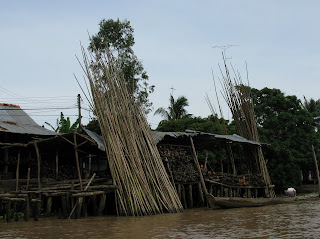After a delicious breakfast at the home stay, we
re-boarded our rocking boat for a trip to another floating market. Mr. and Mrs. Muoi bid us farewell.
On the way we passed several boats carrying rice husks to the brick kilns.


We also went by a bamboo store. They still use bamboo for some scaffolding in construction projects. It is also use for all sorts of other frames and such around houses.

This floating market is in Cai Be, near Vinh Long. It is a different type of market from the one we visited the day before. Here the people come and stay until all of their produce or whatever is sold. Some stay as long as a week. At the previous market the people were local, and usually went home by noon or early afternoon.

And of course there has to be a refreshment boat. Notice the mask the lady is wearing. You will see numerous people wearing them, mostly women, when driving motor bikes to prevent breathing in the dust and other pollutants. I'm not sure why this lady was wearing one, as the air is very clear in the Delta. Even in the cities I have never found it to be offensive. But there is a lot of dust on the roads.
Another thing you will notice in both of the previous pictures is the propellers on a long shaft sticking up in the air. These are the Vietnamese equivalent of an outboard motor. The straight shaft is so they don't need a lower gear box to change the direction from vertical to horizontal. They are powered by Russian engines that make a thump-thump sound when they are running. Smaller boats often use the motor for directional control also, while larger boats usually have a rudder.

Coming into
Vinh Long we passed this row of houses. Note the TV antennas. Nearly every house in Vietnam has a TV, no matter how poor. The cities all have cable, but apparently they don't down in the Delta.

We got off our boat to visit some local "factories." On the way we passed this church with children out front having sack races.

The first factory we went to was for making rice paper. It was a true, small factory. Women here work eight hours a day over hot pans making about 2,000 rice paper cakes. For this they
receive the equivalent of about $6, which is good wages for Vietnam. The base salary for teachers is about $100 per month. It was so hot inside that it actually felt cool when we went back outside.

As you can see, the workers are used to having tourists
traipse through their workplace. Evidently the owner gets some kickback from the tour companies.
Next we went to another shop that made a different type of rice paper, large and thicker than the previous shop.


To the left our local guide is explaining the process. I put "factories" in parenthesis before, as it is clear that most of these shops are set up to demonstrate the process to tourists. They only have one station for each type of work. We also visited candy and rice bar making shops.

Each of these shops had an area where you could sample what they made, and buy it, or other assorted tourist
paraphernalia.
We visited an actual sea salt factory before taking our boat back to the bus for our return to HCMC. The sea salt factory used rice husks for fuel, as did some of the stoves in the shops. It isn't clear how many husks might be left for Dr. Ni's logs. The logs do have the advantage that they are easier to transport than the bulk husks.










 Each of these shops had an area where you could sample what they made, and buy it, or other assorted tourist paraphernalia.
Each of these shops had an area where you could sample what they made, and buy it, or other assorted tourist paraphernalia. 


0 Comments:
Post a Comment
Subscribe to Post Comments [Atom]
<< Home